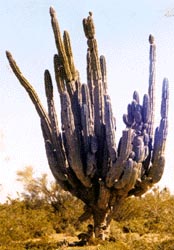|
San Lorenzo Reserve
|
||||||||||||||||||||
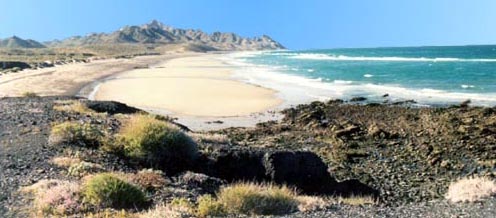 |
||||||||||||||||||||
|
Location/Description: The area of San Lorenzo that is to receive protection from the SDCC in the near future is located on the coast of the Gulf of California directly south of the fishing village of Puerto Lobos. San Lorenzo is an oddly shaped 32,550ha (80,398acres) parcel of land, which encompasses the entire bay of Bahia de San Lorenzo (referred to as Bahia Tepoca on some maps) and the entire mountain range of Sierra Colorada. The SDCC is currently in the process of purchasing this area from the ejido (communal village) of Avila Camacho (see immediate goals). The mountains located in the area of San Lorenzo are varied in their substrate and origin. In vicinity of Puerto Lobos, on the northwest corner of San Lorenzo, are the remnants of a volcano, evidenced by a small, 180m (540ft), symmetrical peak of black basaltic rock, known as Cerro Prieto. Southeast of Cerro Prieto, starts the mountain range of Sierra Colorada which consists of granitic, basaltic, and marble substrates. The variety of rock substrates results in fascinating formations, such as arches and windows within the rocks. Towards the center of San Lorenzo, the Sierra Colorada reaches a maximum height of 727m (2175ft). This may not appear very tall, yet keep in mind that it is almost the altitude of Tucson, Arizona which in this case is reached adjacent to the Gulf of California. The result is an impressive topography of a step gradient, and it is amongst these mountains that one may find extant herds of desert bighorn sheep (Ovis canadensis nelsoni). |
||||||||||||||||||||
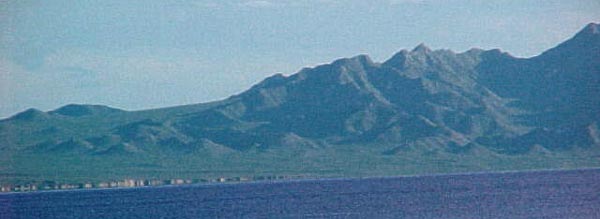 |
||||||||||||||||||||
|
Due to habitat degradation and extensive hunting, the desert bighorn sheep is seriously threatened throughout the southwestern United States. As this distinct subspecies became rarer and harder to obtain, the value for trophy hunting of desert bighorn sheep has increased dramatically (the permit for one sheep can cost as much as $200,000). Consequently, wealthy private land owners have purchased extensive mountain ranges from various ejidos in order to privately manage profitable hunting reserves, known as Ranchos Cinegeticos. The mountain ranges to the east (Sierra Viejo), and to the south (Sierra Julio) of San Lorenzo, are currently active examples of these private hunting ranches. The ejido of Avila Camacho has the area of San Lorenzo registered as a hunting ranch. This is not because bighorn sheep are actively hunted there, but rather in order to allow the neighboring hunting ranches (Sierra Viejo, and Sierra Julio) to follow and kill a sheep on the land, if they need to. If a kill does occur on the land of San Lorenzo, the ejido would receive 10% (about $20,000) of the value of the hunting permit. In addition to large herds of desert bighorn sheep, the area of San Lorenzo also harbors other threatened and endangered species, such the Gila monster (Heloderma suspectum), and the desert tortoise (Gopherus agassizi), both of which are species sensitive to arthropogenic impacts, and illustrates the fact that the area of San Lorenzo encompasses a vast expanse of pristine Sonoran desert. |
||||||||||||||||||||
 |
||||||||||||||||||||
|
The vegetation of the area supports this contention, especially by the fact that nonnative species have yet to be found (West, pers. comm.). The vegetation of San Lorenzo is remarkably diverse, representing transition zones of various Sonoran Desert subdivisions. This is exemplified by the columnar cacti, represented by four species, saguaro (Carnegia gigantea), sinita (Lophocereus schottii), organ pipe (Stenocereus thurbei), and cardon (Pachycereus pringlei). Some of the floral assemblages reach their northern most extension here such as foothills thornscrub in the mountains, and mangrove estuaries in the vicinity of Puerto Lobos (Brown and Lowe 1980, Brown 1994). The predominant vegetation is that of the Central Gulf Coast subdivision, which contain a significant number of species of disjunct populations that are localized to this area in Sonora, yet widely distributed on the Baja California peninsula (Brown 1994). Of particular interest is the boojum tree (Foqueria columnaris), which is characteristic of the Vizcaino region on the Baja California peninsula and occurs in the mountain range of Sierra Cirrio, just south of San Lorenzo (Humphrey 1974). Unfortunately, Sierra Cirrio is now a private hunting ranch and access is prohibited or very limited at best, even to the local communities that have historically used the land. Also found on San Lorenzo, are extensive growths resembling forests of cardon cacti (Pachycereus pringlei) and elephant tree (Bursera microphylla, and B. hindsianum). The cardon is an awesome columnar cactus that dwarfs the saguaro (Carnegia gigantea), both in height and mass. Please note the size of the person bellow the cardon cactus in the following picture. |
||||||||||||||||||||
|
||||||||||||||||||||
 |
||||||||||||||||||||
|
This area has been referred to as a “special place” by National Geographic, and has an aerial photo of these cliffs in the October 2000 issue (pages 38-39).
The intertidal and subtidal substrate is composed of a hard basaltic diabase rock in the vicinity of Puerto Lobos, which harbor a depauperate assemblage of fish (Thomson 2000), and intertidal invertebrates (Brusca, 1980). Towards the opposite end of Bahia San Lorenzo, in the vicinity of Sierra Julio, the intertidal is composed of large basalt and granite boulder fields, which in contrast to Puerto Lobos, harbor an incredibly diverse assemblage of intertidal invertebrates. The picture bellow illustrates one of the intertidal boulder fields, being surveyed by University of Arizona students. (see Research) |
||||||||||||||||||||
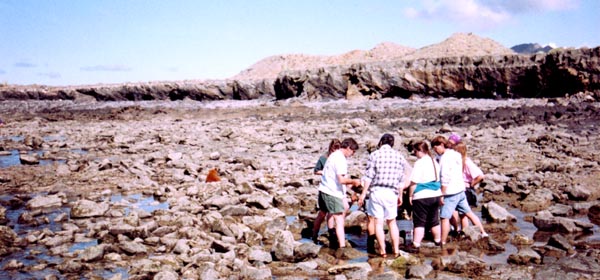 |
||||||||||||||||||||
|
The intertidal invertebrate assemblages of this area are particularly unique in containing significant numbers of organisms that were once common at other sites, such as Puerto Penasco (e.g. the gastropod Onchidella hildae, and the echinoderms Echinaster tenuispina, and Heliaster kubiniji Mangin pers. comm.) The subtidal environment is characterized by a series of offshore patch reefs. These are not coral reefs, as the reef is not built by hermatypic corals, but instead is built by the honey comb tubeworm, Phragmatopoma californica. This sabellid tubeworm is found predominately in the intertidal of California, where it forms huge bands of a honey comb structure by cementing small sand particles (Ricketts and Calvin 1964). The disjunct population of P. californica, found in the southern end of Bahia San Lorenzo, is the only known occurrence of this species throughout the Gulf of California (Brusca pers. comm.). In this area, P. californica inhabits the subtidal, where the honey comb tube structures create massive reefs. The invertebrate and fish assemblages found on these reefs resemble those of true coral reefs, and in effect the Phragmatopoma reefs of San Lorenzo are structurally, and ecologically analogous to coral reefs. |
||||||||||||||||||||
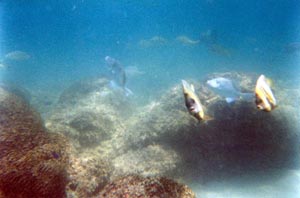 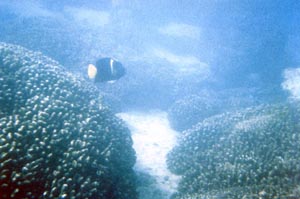 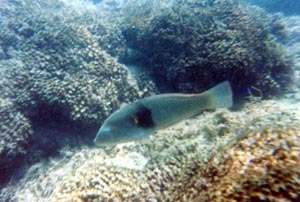 |
||||||||||||||||||||
|
The pictures above illustrate the similar topography, and habitat heterogeneity between coral reefs, and the reefs of San Lorenzo. The first picture is of the only coral reef in the eastern Pacific at Cabo Pulmo, at the tip of the Baja California peninsula. They consist predominantly of the hermatypic coral Pocillopora elegans. The remaining two pictures are of the reefs at San Lorenzo, which are formed by the tubeworm Phragmatopoma californica. Note the similar rounded growth patterns of both of the reef building species.
|
||||||||||||||||||||
|
||||||||||||||||||||
